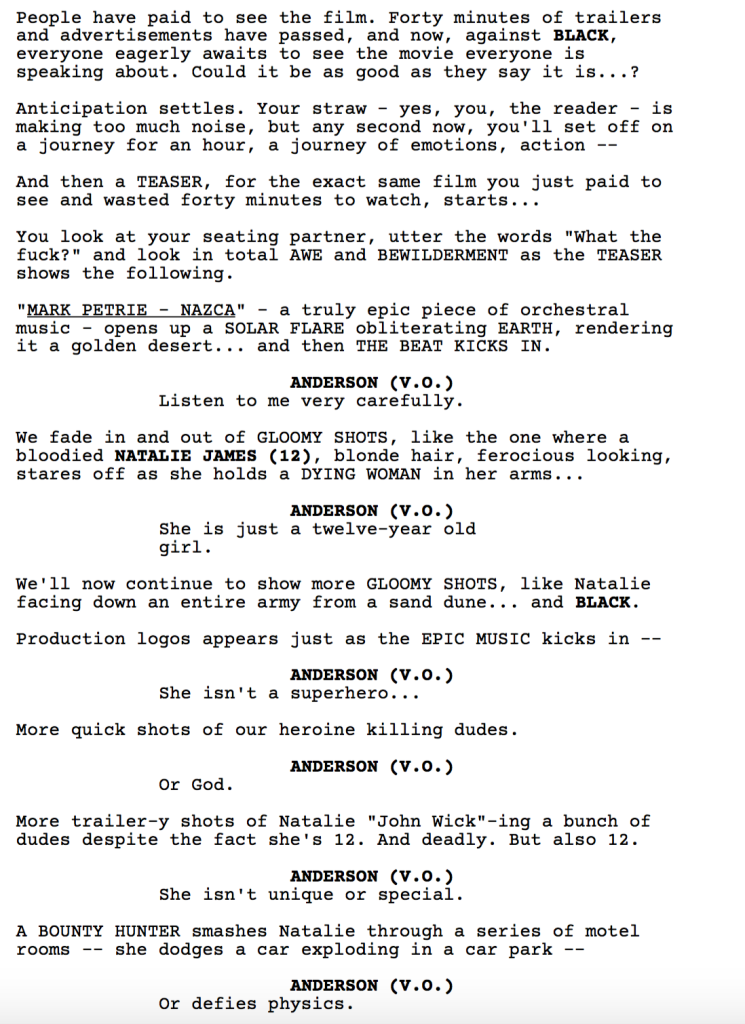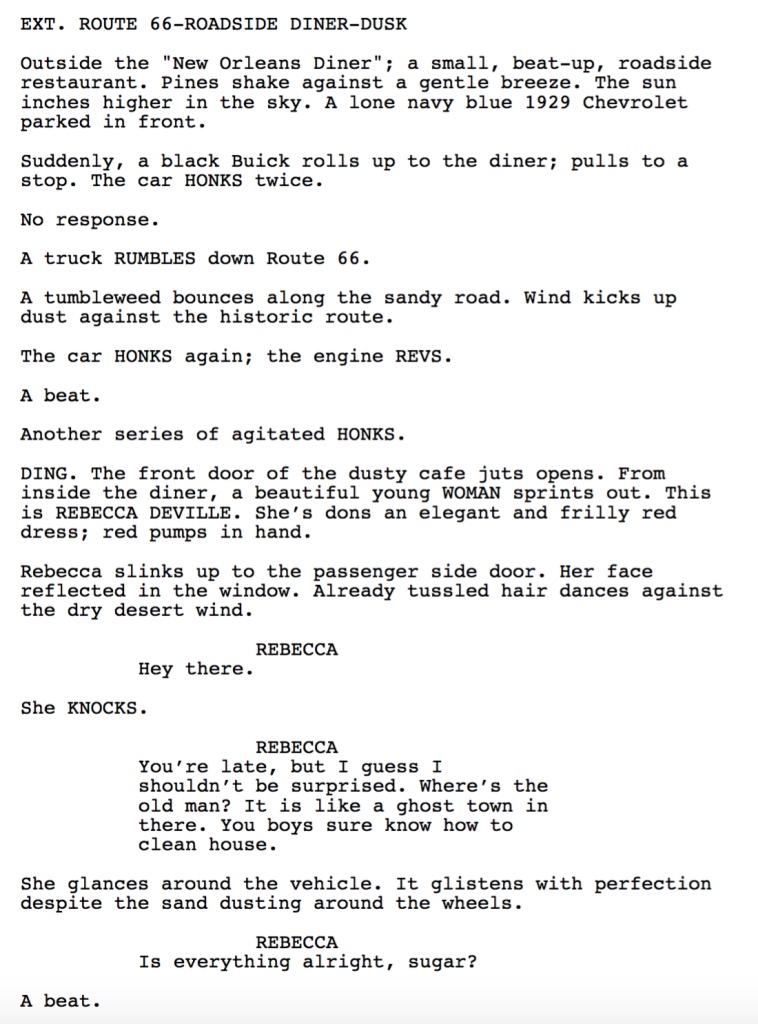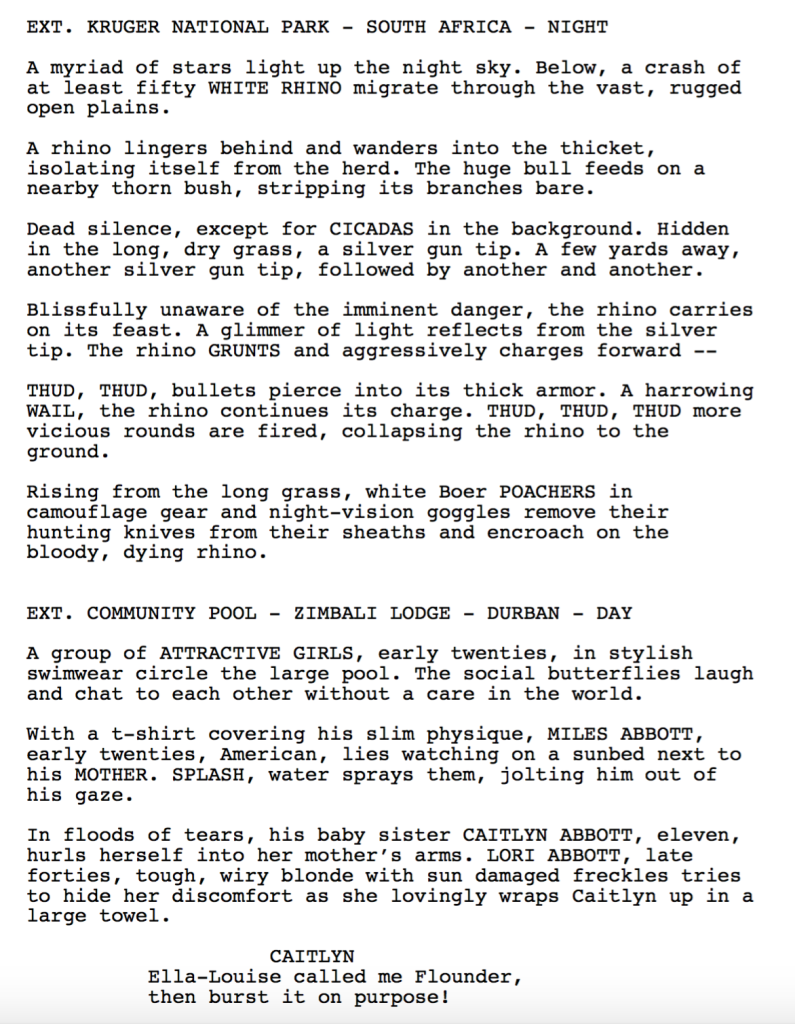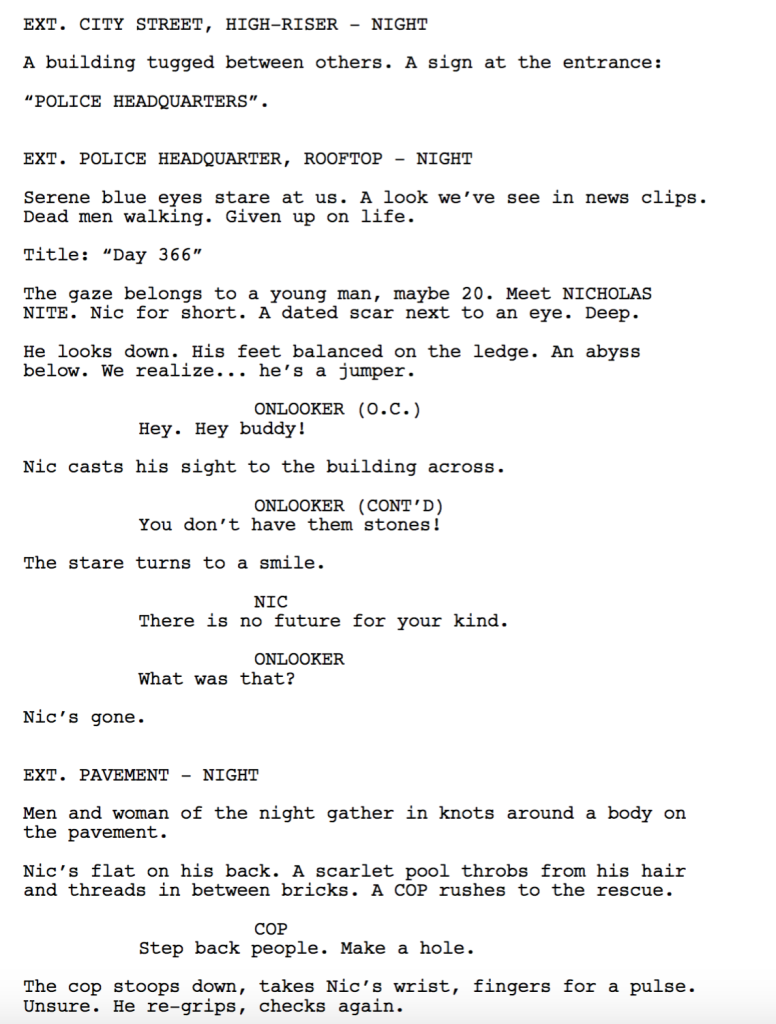I’m obsessed with Wrinkle in Time and Ready Player One. They both have interesting storylines behind them. Wrinkle in Time is a film that Diversity-Destined-Disney was counting on to become a hit but, based on tracking, isn’t looking like it will be. What does that mean?? Ready Player One was supposed to be the ultimate geek smorgasbord. But the trailers promise a muddy generic CGI-fest without any vision. Has Spielberg lost it? If this doesn’t do well, this will be his weakest stretch as a filmmaker in his entire career. Which sucks! Cause I really loved the Ready Player One novel. Also, if movies like this don’t do well, it means more Marvel movies. Do we really want more Marvel movies??
If you’re new to Amateur Offerings, read as much as you can from each script and vote for your favorite in the comments section.
As always, winner gets a review next Friday. And if you believe you have a screenplay that will light the world on fire, submit it to Amateur Offerings! Send me a PDF of your script, along with the title, genre, logline, and why you think people should read it (your chance to pitch your story). All submissions should be sent to Carsonreeves3@gmail.com.
Title: The Notorious Natalie James
Genre: Post-Apocalypse / Action-Western (“John Wick” meets “Mad Max: Fury Road”)
Logline: In a deranged post-apocalypse, a renowned twelve-year old killer plots to steal a mysterious map from the illusive crime-boss responsible for her father’s brutal death.
Why You Should Read: Based on my well-received children’s book, “THE NOTORIOUS NATALIE JAMES” is JOHN WICK meets MAD MAX: FURY ROAD with a dash of SCOTT PILGRIM and is exactly what you’d expect when you put those films together – over-the-top action, insane fight choreography, kinetic, feverish energy as well as a unique blend of deliriously fun and weird, gonzo humor that elevates this above the other Jane Wick wannabes. — I’ve always wanted to explore the importance of childhood in a unique way, and with this, I believe I’ve done it in a way that will make for a good discussion! Plus, it isn’t that hard to market. I’ve wanted McKenna Grace to be Natalie, but who do you think should be her, Scriptshadow?
Title: The Exchange
Genre: Political Action, Thriller
Logline: A determined woman breaks an African terrorist leader out of prison, in order to exchange him for her kidnapped husband.
Why You Should Read: This film sheds light on a social economical problem that has plagued one region for decades, while also delivering an entertaining thriller about a woman who has already experienced a devastating lost, desperately doing everything she can to hold on to all that she has left. Money is a major theme throughout the film. Not just greed and the evils that is spawns, but also equality. Wanting what is rightfully yours, wanting what you feel you deserve. Unlikely bonds are formed, loyalties are questioned, and hearts are sent racing in this political action thriller that spans across two continents.
Title: Helldorado
Genre: Crime/Noir
Logline: On a case to track down a missing girl, a detective partners with the tortured ghost of his dead brother to uncover a conspiracy that will prevent the construction of the Hoover Dam in 1920s Las Vegas.
Why You Should Read: I recently watched “Mute” on Netflix and was instantly underwhelmed. I thought to myself, how can something so cool have been so unsatisfying. I love crime/thriller/noir films. But mute left me silent. This reminded me that I wrote a similar screenplay that I think is much better. I called it, “Helldorado”. This story is based 100% on an out-of-body experience I had where I was partnered with a detective and the ghost of his dead brother as they solved a crime in 1920’s Las Vegas. I immediately put the story to paper…and this was the result.
Title: Night of Game
Genre: Action/Thriller
Logline: On a safari trip, a family are driven off-road by rhino poachers and forced to survive a harrowing night in the bush.
Why You Should Read: “In 2017, a reported 1,028 rhinos were poached in South Africa. At this current rate, wildlife experts warn that rhinos may become extinct as early as 2020.” About me, I’ve been a dedicated screenwriter for over six years and like the majority on this site are determined to move to the next level. “Night of Game” is a unique concept with high stakes, emotional conflict, and bloodthirsty action within an urgent timeline. It’s a movie that will spread awareness of the barbaric act of poaching horn to sell to China and Vietnam. I’m truly passionate about the cause and hope that Carson and the scriptshadow faithful can help this scripts journey to the silver screen.
Title: Reminiscence
Genre: TV Pilot Sci Fi / Drama 60p
Logline: A young student dies in an accident and unbeknownst to his family is replaced with an Artificial Intelligent being that is tasked to socially integrate.
Why You Should Read: Produced writer in South Africa. Always loved SciFi and an interest in AI and I hated the dumbing down of AI beings and with Musk’s open AI and the other tech giants starting something I wanted to up the game on WestWorld, Alita-battle angel, Blade Runner.
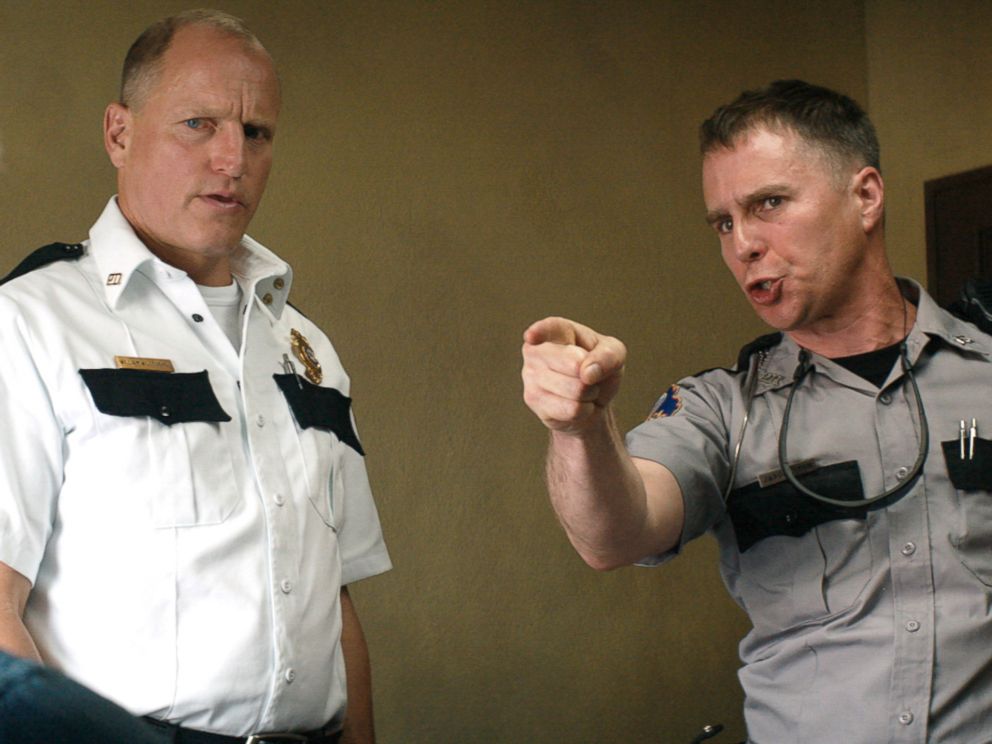
Usually I give you guys formal screenwriting advice. But today I’m going to change things up and give you screenwriting HACKS, flashy tips that aren’t meant to guide you to the perfect screenplay so much as spice your script up. You can use two of them. You can use seven of them. It’s up to you. They will never make nor break your script. But they will HELP. Let’s begin!
1 – A concept you don’t have to defend – I see this all the time. Someone will pitch me an idea like, “A group of people trying to make it in Los Angeles endure a series of obstacles but eventually come out on top.” The writer will then immediately launch into a defense of his logline before I even say anything. “I know that sounds generic. But what it’s really about is this guy who runs an acting workshop and see…” I’m not saying the above idea would make a terrible script. If the writer knows character, it could be great. But we’re talking about hacks here, things to make your job easier. You do this by coming up with a concept that speaks for itself, that isn’t so boring that you have to defend it. “A young African-American man visits his white girlfriend’s creepy parents for the weekend, and begins to suspect that they’ve brought him here to hurt him.”
2 – At least one big character – Big characters jump off the page and get big actors attached. The kind of character you’re generally looking for here is a chatterbox with opinions who’s a little bit crazy. Juno. Ladybird. Walter from The Big Lebowski. Louis from Nightcrawler. Mildred from Three Billboards. Dixon from Three Billboards. This is one of the easiest ways to make your script stand out.
3 – A flashy opening scene – This is a TV pilot staple. But they’re available to you feature writers as well. Give us a scene that grabs us right away. If it doesn’t fit into the timeline of your story, you can make it a flash-forward. Those first 5 pages are when you’re being judged the harshest. It’s when the reader is literally thinking, “I have to read another terrible script before I can get to my own writing??” Give’em a hell of a great scene, like the opening of Scream (one of the most famous spec scripts ever), Inception, or all the James Bond films, and they’ll want to stick around.
4 – Efficient description – Keep your paragraphs to THREE LINES AT MOST. Make most of them TWO LINES AT MOST. If that scares you, good! Scripts are supposed to be easy to read. Not a chore. Learn to be a poet, to say as much as possible in as few words as possible.
5 – A small group of strong characters as opposed to a large group of average characters – Spec scripts work best with a tight cast of characters. Fight it all you want. It doesn’t change the fact that the screenwriting format LOVES setups with 4-5 main characters. Cloverfield 13, Get Out, Ex Machina, Room. All of these superhero movies with 30 characters are not spec scripts and therefore don’t require an overworked reader to keep track of all 30 people. Also, a small group of characters allows you to focus the story and give those characters more attention. So look for ideas that favor this setup.
6 – Dialogue that’s a model, not a mannequin – Mannequin dialogue is the bare essentials. It’s the shape of the human, but there’s no expression or individuality to it yet. A model, on the other hand, has a face that can express emotion. Hair that can be styled. You can dress her in something classy, sassy, slutty, distinguished, whatever you want. Here’s a scene from Three Billboards, where Dixon (Sam Rockwell) is drunk and badgering Mildred at the bar. A patron tells Mildred she sounded great in her TV interview yesterday. Here’s the “mannequin” version of Dixon’s dialogue: “Why are you encouraging her? What she’s doing is wrong.” Note how straightforward and generic that is. Anybody in the world could’ve said it. Now here’s the “model” version, which was used in the movie: “I didn’t think you came across really good in the things you were saying. I thought you came across stupid-ass.” Dixon is an idiot, a 6th grader in a man’s body. We see that here in his butchered grammar and low level vocabulary. This is how you dress up dialogue. You have it express the individual who’s speaking.
7 – An antagonist with personal motivation rather than general motivation – Marvel keeps screwing this up but there are signs of course-correction. Having a bad guy who wants to collect some item so they can harm the world is boring because it’s generic. But a bad guy who has a personal beef with the hero, as we saw with Black Panther, is interesting because it’s specific. If that doesn’t work, consider a personal beef adjacent to your hero. This is what Spider-Man: Homecoming did. The Vulture wanted to hurt the city because they went back on their contract with him, leaving him high and dry in his career and his family. Villains with solid motivations juice a story up.
8 – One giant setup and payoff – You can have as many setups and payoffs as you like. But you need one great one. Setups and payoffs are so fun and audiences LOVE them. Unfortunately, I don’t see as many of them as I used to. The Rita Hayworth poster in The Shawshank Redemption. The snakes in Indy. The clock tower storm in Back to the Future. Where are my current setups and payoffs at?
9 – A twist ending – I hesitate to put this here but nothing affects a reader more than a twist ending they never saw coming. It’s got to make sense for the movie. But there isn’t a single device that can upgrade a script faster than a great twist ending.
10 – At least one scene you KNOW everyone will be talking about when they leave the theater – I can’t tell you how many scripts I read without a SINGLE memorable scene. You need a scene that defines your movie. Achieving this is easier than you think. Just come up with a scene idea that you know audiences will have a strong reaction to. Fish sex for The Shape of Water. The peach scene in Call Me By Your Name. Dixon throwing the advertising agent out the window in Three Billboards.
There ya go. Now go hack at it!

Devastating news, my friends. I’m under the weather. I couldn’t muster the strength to read and review a script. This stuff takes more brain power than you think. But I hate leaving you guys with nothing, so I wanted to highlight something someone brought up in the comments section yesterday. Jordan Peele quit writing “Get Out” 20 times. Think about that for a moment. If any one of those times took, he would not have been standing at the front of the most prestigious movie awards ceremony in the world accepting an Oscar on Sunday. One of the most difficult things about writing is that you get so close to a script that all you can see are its faults. You may even start to hate it. These are the moments when you want to hang it up. Don’t. If you believed in your script with all your heart when you started it, there’s something there. It’s your duty to finish it and get it out there. You never know what could happen. :)
Is Apple’s flagship “See” the “Game of Thrones” slayer it so desperately wants to be?
Genre: Science-Fiction
Premise: In the distant future, after a virus has left less than 2 million souls on earth, tribes of people attempt to survive without the most basic human sense – sight.
About: When a media company worth 900 billion dollars lets everyone know they’re entering the TV space, everyone in that space gets really f’ing nervous. We live in a TV world that’s increasingly becoming harder and harder to stand out in. The only way to do it is with big money. And no one has more money than the house that Jobs built. “See” is one of their flagship programs, and it comes from Francis Lawrence (Red Sparrow, The Hunger Game sequels) and Steven Knight (Eastern Promises). Lawrence is quoted as saying that they’re going to be able to do stuff with this show that you never get to do in TV. Can’t wait to find out what that’s all about!
Writer: Steven Knight
Details: 69 pages (Third Draft)

With all of the screenplays I read, it is rare that I come across an idea that I truly consider original. I’ve never seen an idea like this in the television world. I’ve seen a movie covering similar territory – Blindness – but that was one of the worst movies I’ve ever had the misfortune of sitting through.
Sight-challenged subject matter, unless you’ve got Al Pacino, is a TOUGH thing to film. I mean, you’re watching people literally stumble around in the dark. To put an entire cast into that world is one of the riskiest things I’ve ever seen. And when you’re introduced to the world-building here, with entire towns built around strings and ropes that the inhabitants use to pull themselves around, you’re thinking, “They’re going to do this for 70 episodes?”
I kept waiting for the moment where some miracle light came down and all of a sudden everyone could see. But I don’t think that moment’s coming. We’ve got babies who can see. But that isn’t going to pay off for another 15 years. What do we do in the meantime?
Maybe I should break down the plot for you. The year is 2600-something. We’re high up in the mountains in a weird village that has, like I said, ropes and pulleys and shit. Through some title cards, we learn that back in the 22nd century, a virus swept through the planet that killed almost everyone. Anyone who remained was left sightless.
Over in a cave, a strange woman, an intruder of sorts named Maghra who only joined this clan weeks ago, is pushing out twins. Meanwhile, the clan’s leader, a giant of a man named Baba Voss, is dealing with an approaching army. He can’t see this of course. No one can. But in a world with no sight, you use your other senses acutely, and sense-specific generals use their hearing to note that hundreds of horses are coming up the mountain. They will be here soon.
Via a series of conversations throughout the village, we learn of a mysterious man named Jerlamarel. He was the man who got Maghra pregnant then disappeared. It is rumored that Jerlamarel had sight (vision is considered witchcraft in this time, so sight is never talked about). Jerlamarel left a message (messages are written via a series of knots in ropes) that there is a secret bridge off this mountain that will take everyone here to a new land.
Because they are vastly outnumbered by the approaching army, the village decides to flee to this rumored bridge. After they cross it, they find their way into a valley, a valley overlooking a once-familiar but now dead skyline, that of New York City. What they don’t know is that they’re moving towards another village, a village led by a woman with one goal – to find and kill the witch babies who have inherited the power of sight.
Does the word prayergasm mean anything to you?
Oh, it will.
What I really liked about “See” was that it had an extremely complex world it needed to set up, but said, “Fuck it. I’m not only going to set this world up. I’m going to entertain you while I do it.” It kills me when young writers make the mistake of believing that because everything in their fantasy world is soooooo complex, it needs 70 entire pages of dry setup. There can be no fun when you’ve got the Squybar language to establish, and the Tenth Thistle Law that the reader has to know to understand why the War of 2119 ended in the Calagar Revolution.
Your job as a writer is to tell us those things WHILE ENTERTAINING US AT THE SAME TIME. Trust me. However complex you think your world is? It’s not a tenth as complex as this one. And yet we already have a war on page 10 in “See.”
This is a testament to the old advice: Start your story as late as possible. Sure, Knight could’ve given us 30 pages of setup before the war. But that’s not how good storytelling works. Especially these days when viewers have LITERALLY 400 other options to turn to. You have to grab people fast. So we grab and go with a war and then an evacuation.
I was shocked they made that choice, to be honest. Usually, when you have TV shows, money is tight. If you’re going to build an elaborate village on a mountain with an intricate system of movement and engagement? In a normal show, you’re going to use that set for AT LEAST your first season. That set gets torched by page 50 here. I guess this is what Apple was talking about with their deep pockets. You think you’ve got money Netflix? That’s pocket change for Apple.
So I didn’t know what the hell was going to happen once they left. But I’ll tell you one thing that happens. Prayergasm. Queen Kane, who rules the only town in the world that still has electricity, masturbates whenever she prays to God. And hey, why not? Nobody’s going to catch her. Even if they hear her, it’s easy to deny. “Queen? Are you buttering your muffin again?” “Um, no!” “I thought I heard something.” “Prove it.” Argument won.
The cool thing about this concept is that it places the audience in the unique position of knowing more than the characters. So, for example, in the scene where the fleeing village people are approaching the cliff and looking for this rumored bridge. Everyone is desperately looking around, dangling perilously near the cliff that the bridge crosses, tempting fate with each step. WE can see that the bridge is right there. But they’re clueless. That adds a unique form of dramatic irony that allows us to ball our fists and scream out, “It’s right there! It’s right in front of you! Just keep walking.” This opens up avenues you can explore on multiple levels throughout the series.
What I wonder about is the staying power of this hook. Its biggest asset is also its biggest weakness. Will audiences stick with characters flailing around like drunken sailors season after season? I don’t know. There are no old comps to compare this to. Everything is brand new and therefore unknown.
But I like that. If these are the kinds of risks Apple is going to be taking, then they can definitely take on “I don’t know how to make good movies” Netflix and “We Only Have One Good Show” HBO. All you need is a couple of winners and you’re a player baby.
[ ] What the hell did I just read?
[ ] wasn’t for me
[xx] worth the read
[ ] impressive
[ ] genius
What I learned: Knight will occasionally use a tactic where we meet an important character, but due to the way the story’s set up, the intro to that character needs to be brief. So Knight will write, right after the character intro: “We will get to know this person well.” Knight understands that when tons of information and new characters are being thrown at the reader, it’s difficult to know what needs to be remembered and what can be filtered out. Adding that little tag is a thoughtful way of saying to the reader, “I don’t have time to get into this person’s deal now. But since you have to remember so much shit, I want you to know he’s important. So don’t forget him.”
Genre: Gothic Horror
Premise: Two hitmen are recruited by a strange Native American woman to kill a bizarre monster who lives under her basement.
About: This script was written in the mid-70s for Hal Ashby’s production company. Ashby is best known for the weirdest love story of all time, Harold and Maude, a personal favorite of mine. He was obsessed with this project though, coveting Jack Nicholson to play the lead. He had the author of the book, Richard Brautigan, adapt the screenplay himself, but was unhappy with the result. So he got a real screenwriter in Michael Haller to adapt the story, the final product of which he was excited about. But he could never get all the pieces together. Later, Tim Burton would become obsessed with the project, but he also had trouble getting it made. This is the Haller version of the script.
Writer: Michael Haller (based on the novel by Richard Brautigan)
Details: 108 pages

Still getting over that Oscar hangover?
Texting your buddies to remind them when tonight’s Bachelor Finale Viewing Party starts?
I’m right there with ya. Mine starts at 6:30. I invited all my neighbors but for some odd reason, when I approached them with roses and asked, “Will you accept this Bachelor Viewing Party Rose?” 5 of them shut the door in my face, 3 stood silently, and 2 called the police.
The good news is I made bail. So onwards and upwards and let us all hope Ari finds love.
A few of you sunk your teeth into me the other day like a diseased zombie when I eviscerated some script choices in Three Billboards, calling me delusional for blindly following the GSU faith. But anyone who reads this site regularly knows I like a lot of weird scripts. I mean, I liked Meat, which was the anti-GSU. I’m also consistent in saying that how you break the rules is how you will make your script stand out.
Where myself and my critics differ is in intentional rule-breaking vs ignorant rule-breaking. I’m fine when someone breaks a rule with a purpose. But when I sense they made a choice ignorantly, either overall or in a specific area, I’m going to call them out on it. If you overlook a more dramatically engaging choice out of sloppiness, that needs to be discussed. Because while the strength of that film may have masked that particular mistake, aspiring screenwriters need to know that it won’t work if they try the same thing.
How does this tie into today’s screenplay? Because today’s script is a more obvious example of what happens when you abandon structure, instead “writing from the heart” and steering your choices through theme.
The year is 1902. Two hitman, Cameron and Greer, are coming back from a failed job in Hawaii. Greer is the brains of the operation while Cameron’s a bit of an autistic weirdo. Everything is counting for him. He counts footsteps, words, repeated noises, everything.
When these two get back to the mainland, they’re approached by a young beautiful Native American woman named Magic Child. Magic Child hands them a few thousands dollars and says they need to come back with her to Oregon to kill something.
At a time when Coke cost negative 5 cents, a few thousand dollars is a lot of money. So these two don’t hesitate in accepting the offer. However, once they get back to Magic Child’s town, shit starts getting weird. They go back to Magic Child’s mother’s house, Miss Hawkline, and within five minutes, Magic Child and Miss Hawkline become the same person. So there are now two Miss Hawklines.
Sure, why not.
Original Miss Hawkline explains that Cameron and Greer need to kill a monster for them. This monster lives underneath their basement, in something known as the Ice Caves. You see, Miss Hawkline’s scientist husband was working on an experiment, and may or may not have accidentally created the monster before disappearing.
Cameron and Greer are all geared up to go, but as the group of four gets to talking, they become distracted, even confused, about why they’re all here. After several scenes of this, they seem to get their senses back, only for Miss Hawkline to confide that the monster has the ability to make them confused. Which is why they’re confused.
Uh-huh. Okay.
This goes on for many more pages, with the group fucking (yes, fucking), having tea, and eventually realizing that the monster they thought was the monster was never the monster. Or… something. In the end, the missing dad comes back and everything is great again. But not really.
Getting back to my point. It’s easy to say that one’s critique of a story choice is incorrect when the overall screenplay works. But when an objectively awful screenplay makes the same mistake, nobody’s there to defend the same reasoning. The reality is that every script is the sum of its parts and therefore if a script does a few things wrong but a lot of things right, it’s still a success. But that does not mean its mistakes are above criticism. And I’d argue that that’s what this site is about – having a discussion about those choices so we don’t make the same mistakes in our own scripts.
The second this script went away from its structured setup – find and kill the monster – to an unstructured one – reality dissolves and everyone talks to each other for long periods of time trying to figure out where they are and what’s happening – it completely falls apart. It’s a terrible choice. And it’s a terrible choice specifically because it abandons structure.
It just so happens that this script is so appallingly bad after that choice that I doubt any of you would disagree with me after reading it. But while the critique of a similarly bad choice in an otherwise good movie (Three Billboards) makes for a more interesting discussion, a bad choice is still a bad choice. Sam Rockwell’s racist character in Three Billboards not becoming the deputy under a new black sheriff was the wrong choice. Period. Dramatically, it was way more interesting than sending Rockwell home to do nothing for the next 30 minutes. And writers need to know that.
Getting back to The Hawkline Monster, the bigger problem here is that poor screenwriters working before the internet had little to no resources for how to structure a screenplay. So you got a lot of scripts like this, which charged strong into the midpoint, only for the writers to run out of ideas. Their solution, then, was to write whatever came to mind for the next 50 pages until they got to the climax.
Sadly, a lot of writers still write this way.
The way to prevent this is to KNOW YOUR ENDING. Once you know what you’re writing towards, it’s the same as picking a vacation destination. You can now look up prices, book the plane, book hotels, study the place you’re going to visit, pack, go to the airport, and show up at your destination. Imagine if you hadn’t picked a vacation spot? You just winged it. You might show up at the airport with a suitcase full of t-shirts and land in Juneau, Alaska during a time of year when all the hotels are booked.
Once you have your ending, you just have to make sure your characters are always moving towards that ending, that there are obstacles getting in the way, and that each ten pages we’re feeling a little less certain that they’re going to succeed. That’s what provides that sense of purpose you need in a story.
If you want to write purely through theme and leave your pacing and purpose up to the powers that be, go right ahead. But don’t be surprised when people look at you sideways after they’ve read your script.
Script link: The Hawkline Monster
[ ] What the hell did I just read?
[x] wasn’t for me
[ ] worth the read
[ ] impressive
[ ] genius
What I learned: Screenwriting is a mathematical writing medium and is therefore heavily dependent on structure. I know people hate to hear it. But it’s true. Until you see it that way, you’re always going to have a hard time pacing your scripts correctly.


